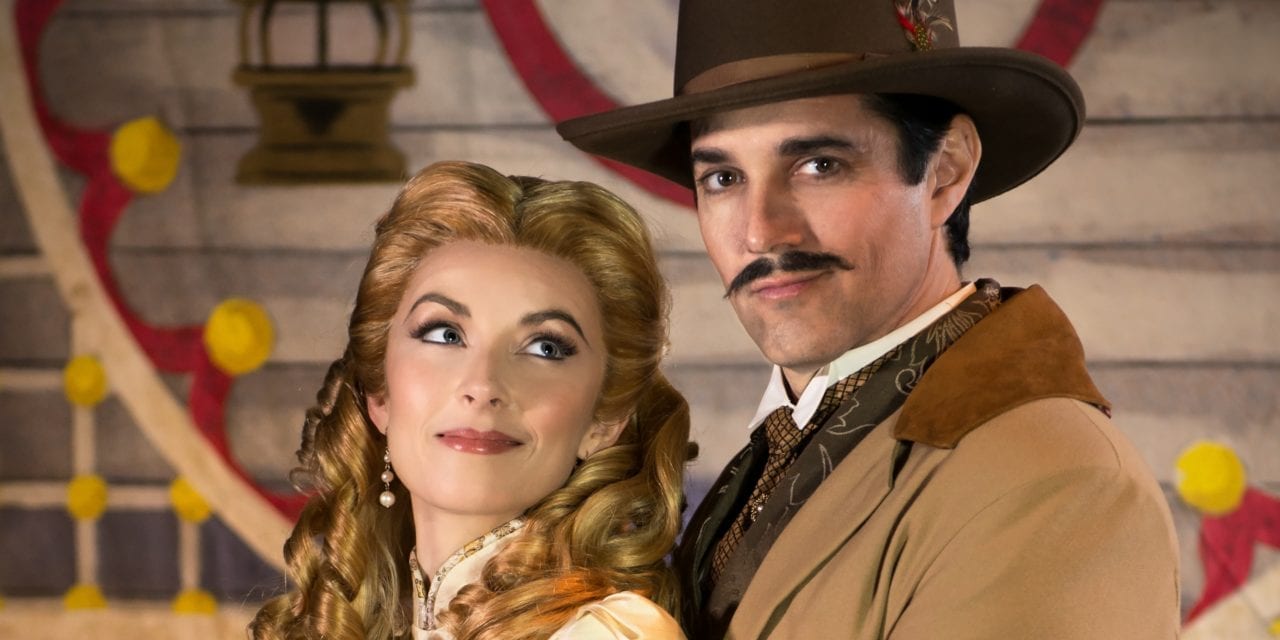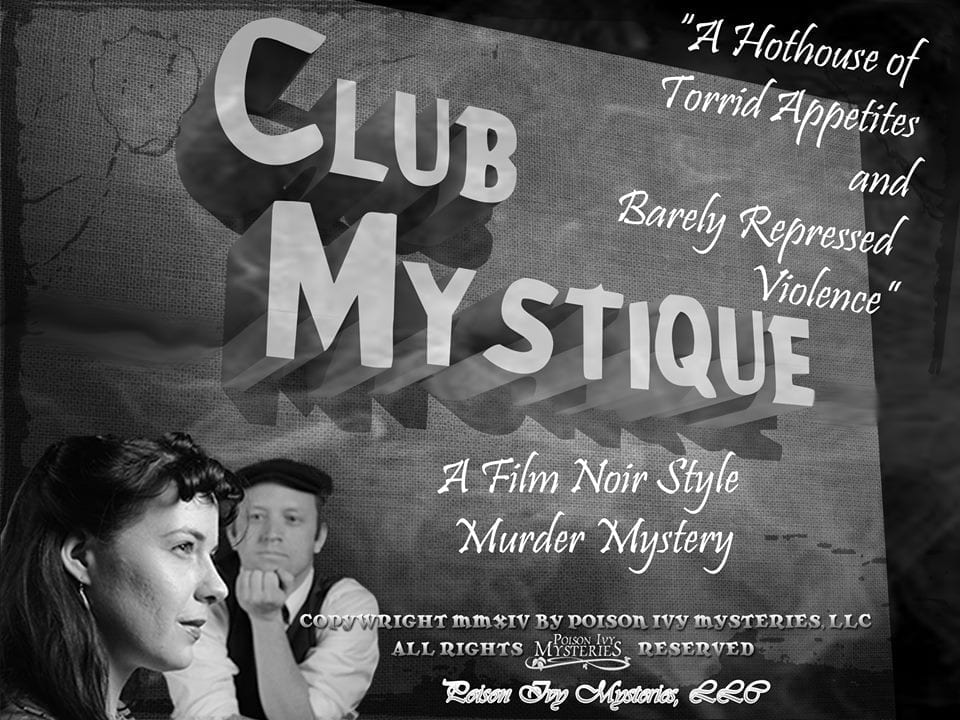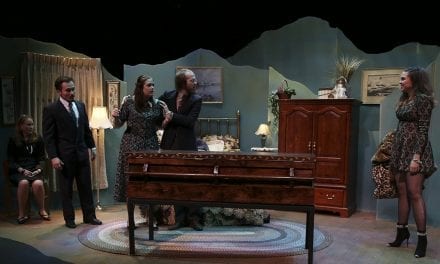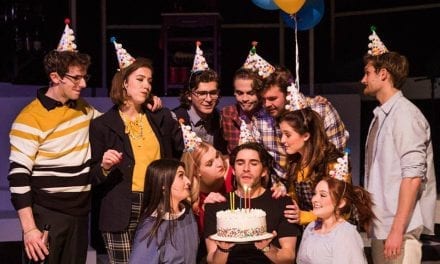LOGAN — In 1992, I was forced to forego my first opportunity to see a touring Broadway show in Salt Lake City to go to scout camp. To a theatre-obsessed twelve-year-old boy growing up in Brigham City, this was nothing short of an apocalyptic turn of events. I bring this up not only to point out to my parents where they went wrong, but also so you will understand what it meant to me when Utah Festival Opera & Musical Theatre began its inaugural season in nearby Logan the following year (then sans the “& Musical Theatre”). It was thrilling to be able to attend productions in a professional venue with a live orchestra so close to home. When I moved to college in 1998, I had seen the majority of the operas and musicals staged by UFOMT in their first six seasons.

Show closes August 5, 2016.
Eighteen years later, I am pleased to return to Logan and the Ellen Eccles Theatre to find UFOMT in its 24th season with an additional, newly renovated venue at their disposal just around the corner. No one is more appreciative than I am of UFOMT’s influence on the Cache Valley arts scene. An illustrative case in point: I saw Back to the Future III in the balcony of the Utah Theatre in 1990. It does my heart good to see UFOMT’s Peter Pan now advertised on its marquee. I tell you this so that you will believe me when I say that I take no pleasure in reporting that their production of Hammerstein and Kern’s Show Boat, though not without its virtues, did not live up to my expectations.
Show Boat tells the story of Cap’n Andy Hawkes (played by Scott Ford) of the Cotton Blossom, a floating theatre that peddles popular live entertainment to riverside towns along the Mississippi at the end of the nineteenth century. When the Cotton Blossom’s romantic leads, Julie (Nora Graham) and Steve (Nicholas Aguirre) are forced to leave the show for violation of Jim Crow laws, Hawkes’s daughter, Magnolia (Vanessa Ballam), and an itinerant gambler, Gaylord Ravenal (Harold Meers), assume their roles. Magnolia and Ravenal soon fall in love and are married by the end of the first act. Act II takes a darker, more complex turn. It explores the precarious nature of a life in show business and gambling throughout the decades after Ravenal and Magnolia leave the Cotton Blossom with their daughter, Kim (Caitlin Ort).
 When Show Boat was first produced on Broadway in 1927, it blazed new territory with songs that contributed to the advancement of the plot (16 years before Oklahoma!) and its treatment of more serious themes than was customary for the genre at the time. Moreover, it was the first Broadway show to feature an integrated cast and chorus, despite the fact that its portrayal of African American characters—such as the dock worker Joe (Brandon Coleman) and the cook Queenie (Gwendolyn Brown)—remains somewhat controversial. Though progressive for its time and certainly intended to be sympathetic, opinions differ on whether Show Boat ultimately perpetuates or critiques negative stereotypes of African Americans.
When Show Boat was first produced on Broadway in 1927, it blazed new territory with songs that contributed to the advancement of the plot (16 years before Oklahoma!) and its treatment of more serious themes than was customary for the genre at the time. Moreover, it was the first Broadway show to feature an integrated cast and chorus, despite the fact that its portrayal of African American characters—such as the dock worker Joe (Brandon Coleman) and the cook Queenie (Gwendolyn Brown)—remains somewhat controversial. Though progressive for its time and certainly intended to be sympathetic, opinions differ on whether Show Boat ultimately perpetuates or critiques negative stereotypes of African Americans.
UFOMT does deserve credit for not avoiding this issue. Their production uses Hal Prince’s 1994 version of the show, which was tailored to invite scrutiny of instances of racial injustice and cultural appropriation. Ushers also distributed a notice in the program urging the audience to “acknowledge the distance we still have to go” in overcoming our “shameful past,” encouraging everyone to “resolve individually to do all we can to right this wrong.” In addition, the festival is sponsoring two seminars on the history of African Americans in the United States as part of its proceedings this year.

Photo by Waldron Creative.
On stage, what UFOMT really excels at is providing an exceptional musical experience. The program lists 57 musicians in the orchestra, though I assume that Show Boat utilizes around 30. At a time when the minimum number of musicians for full-scale Broadway productions is at a historic low (to say nothing of national tours), it is a privilege to hear conductor Karen Keltner realize Jerome Kern’s music as it was intended. Moreover, a first-rate vocal cast, including standouts like Meers and Coleman (whose “Ol’ Man River” justifiably brought down the house), shines a spotlight on the score’s most stirring moments.
Unfortunately, casting for vocal prowess has led to a shallow pool in the acting department. Talent wears thin very quickly further down the cast list, which is painfully evident in a few of the minor speaking roles. The scenes between the glorious musical numbers too often lacked authentic interactions between characters or motivated blocking. At times, I felt more like I was watching overlapping monologues than actual dialogue.

Photo by Waldron Media.
The instincts of some of the better actors—such as Adam T. Biner and Ballam—did go a long way in holding scenes together. However, there is not an actor alive who does not benefit from the right directorial attention. For example, I am convinced that even the prodigiously talented Ballam is capable of better subtext in her crucial first and last scenes with Ravenal. Moreover, where was the vulnerable, tentative Magnolia at the beginning of “After the Ball” at the Trocadero on New Year’s Eve? The difference between the two halves of the song was so slight that anyone who didn’t know the show wouldn’t have understood why the club’s patrons were jeering her. Many of these issues were doubtless exacerbated by what must have been a hectic (repertory) rehearsal schedule. The cast’s self-consciousness in moving around the stage was palpable. Nevertheless, I did not see any problems that could not be improved with appropriate coaching. Ultimately, the buck stops at the feet of director Valerie Rachelle. Perhaps she had larger issues monopolizing her attention, but it falls to her to maximize the company’s potential — and they haven’t reached it yet.

Photo by Waldron Creative.
Some of the show’s technical aspects also failed to impress. The amplification of the actors’ spoken lines was a constant distraction. Whether due to outdated equipment or the way the sound system interacts with the building’s acoustics, an excessive amount of reverberation muddied the dialogue and made the performance space sound far larger than it is. The set mostly consisted of flat backdrops, often with a center cutout from which a three-dimensional structure protruded to enhance the illusion of depth. In some ways, this old fashioned approach felt right at home in a show now in its ninetieth year. However, poor execution in the details pushed the effect from “old fashioned” to “cheap.” For example, the revolving door at the Palmer House in Chicago, featured prominently in the second act and intended to evoke dreams of success, wealth, and sophistication, was structurally insubstantial and cartoonishly painted. The Cotton Blossom’s aged wood planking made a similar impression when it reappeared beneath the stage of the much ritzier Trocadero. Moreover, the long, tedious set changes and 20-minute(!) intermission pushed an evening already plagued by pace issues past the 3-hour mark.
Coming back to UFOMT after so many years, I couldn’t help but feel my nostalgia for their early seasons tinged with disillusionment and melancholy—not unlike Magnolia and Ravenal’s love affair in the second act. I love and will continue to love UFOMT. Nevertheless, they are a fully professional organization working with professional resources, a professional venue, and charging a top ticket price of close to 80 dollars—and so they deserve to be taken seriously, even in criticism. However much I admire this production’s impressive musical accomplishments, Show Boat is not a concert, and a musical requires more than great singing to be successful.





